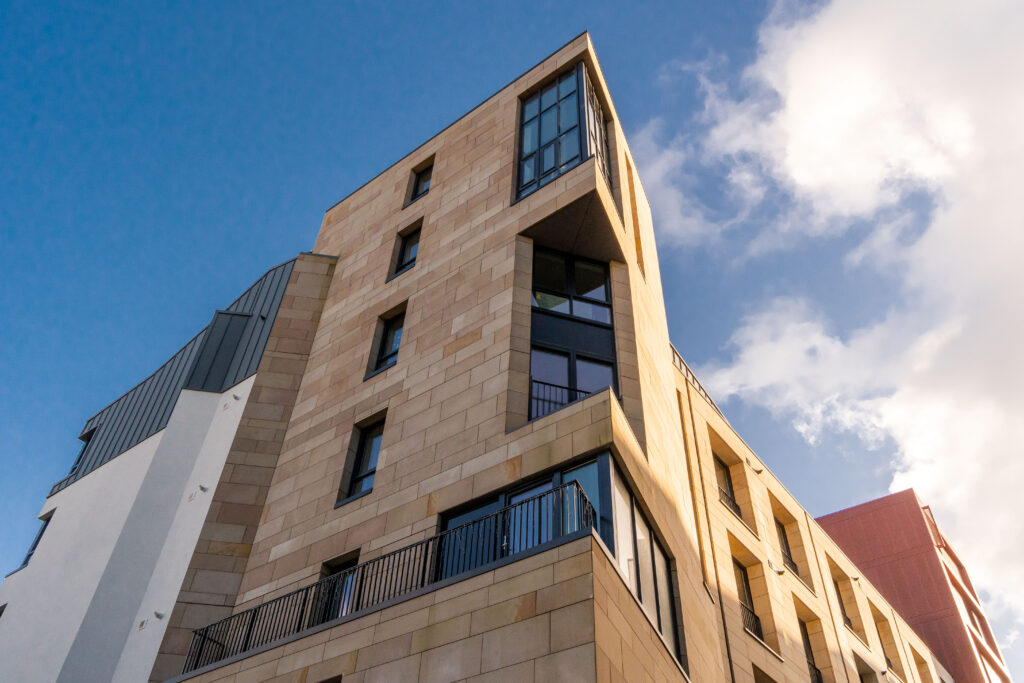In this latest article in our Insight series of in-depth analyses of all-things property, Queensberry Properties’ sales and marketing director, Hazel Davies examines how Scotland’s raw materials have shaped our streets and skylines.
“Scotland has always benefitted from a richly diverse palette of construction materials. The land beneath our feet is impregnated with unique stone, with distinct variations between different regions. These materials have given our major towns and cities very different characters, from the glorious red sandstone dominating Dumfries and Kilmarnock to the formidable granite synonymous with Aberdeen.
“These different types of stone don’t just vary in their porosity and colour. They’ve also influenced the architecture of the buildings they’ve been used in, just as red brick created a distinctive look across the north of England and Portland stone helped to fashion some of London’s finest streets”.
Early years
“Mining has been part of Scottish life since time immemorial, and the stone extracted from the earth has been used to build homes since the Iron Age. The earliest surviving examples of distinctive local materials being used to build structures can be seen in our castles and fortifications – the 13th century Bothwell Castle, for instance. This battle-scarred building incorporated red sandstone rubble on every side, giving it a natural warmth that’s accentuated when the sun hits its southern façade.
Gentlemen prefer blondes
“In the 19th century, blonde sandstone from local quarries in Bishopbriggs and Giffnock was viewed by many as a superior construction material to the softer red stone being quarried across Ayrshire and Galloway. Blonde stone was used in many of Glasgow’s finest boroughs, before stockpiles ran low. By this point, the emergent rail network made it easier to transport red sandstone up from the south. It quickly became the preeminent choice for Glasgow’s late Victorian and Edwardian buildings once the blonde quarries were exhausted, with the added advantage of being easier to carve.
Eastern promise
“While Glasgow’s Victorian forefathers debated the rival merits of blonde and red sandstone, architects and builders in Scotland’s capital had a very different resource to draw upon. Edinburgh occupies the site of an ancient volcano, which bequeathed a “rich legacy of materials like Craigleith stone. During the city’s Georgian boom, volcanic sandstone was used to construct buildings around the slopes it had created millions of years ago – Calton Hill and Arthur’s Seat, for instance. This stone may lack colour, but its durability is attested to by the Old Town and New Town’s many historic buildings.
Hewn from granite
“North-east Scotland has been blessed with an abundance of quartz-rich granite, and this uniquely rugged material was being hewn from the earth from the mid-18th century onwards. Its toughness made it harder to sculpt than softer sandstone, which is why the buildings of Aberdeen and north-east Scotland tend to be angular in appearance. They also lack the ornamental carvings and detailing that adorn so many softer sandstone buildings. There’s often a coldness to granite’s appearance, yet its heat insulation properties are ideal for a region where wind and rain are seemingly ever-present.
Post-war dilution
“As stone quarries were exhausted, closed and built upon, brick became the pre-eminent construction material in the early 20th century. This led to a more homogenous appearance across Scotland’s towns and cities, while the housing shortage created by population growth and two world wars inspired mass adoption of cheap, readily available construction materials like concrete. While Dorran bungalows remained iconically Scottish, a system-built tower block in Cumbernauld was often indistinguishable from one in Croydon or Cardiff. Indeed, many post-war tower blocks were ordered from the same handful of brochures.
“More recently, the use of construction materials across Scotland has been standardised. From brick and stone to harling and cladding, there is a greater diversity of material palettes, yet those palettes are now used interchangeably across the country. Even so, Queensberry Properties continues to choose materials for each new residential development to match existing buildings nearby. Our New Waverley development in Edinburgh’s Old Town for example, incorporates numerous sandstone blocks, helping it to blend into its world-famous surroundings. Sometimes the old ways are still the best…

